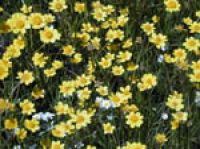| Lasthenia conjugens | |
|---|---|

| |
| Scientific classification | |
| Kingdom: | Plantae |
| Clade: | Tracheophytes |
| Clade: | Angiosperms |
| Clade: | Eudicots |
| Clade: | Asterids |
| Order: | Asterales |
| Family: | Asteraceae |
| Genus: | Lasthenia |
| Species: | L. conjugens
|
| Binomial name | |
| Lasthenia conjugens | |
Lasthenia conjugens, commonly known as Contra Costa goldfields, is an endangered species of wildflower endemic to a limited range within the San Francisco Bay Area of the state of California, USA.[1] Specifically this rare species occurs in Napa,[2] Santa Barbara,[3] Solano, Contra Costa, Santa Clara, Monterey and Alameda Counties.[4] This annual herb typically flowers from March through June, and its colonies grow in vernal pool habitats at elevations not exceeding 100 meters above sea level. The Jepson Manual notes that the present distribution is limited to the deltaic Sacramento Valley, principally Napa and Solano Counties,[5] but the historic range of L. conjugens[4] is known to be significantly wider. In any case, historically the range has included parts of the North Coast, Sacramento Valley, and San Francisco Bay Area[6] as well as the South Coast. Alternatively and less frequently this taxon has been referred to as Baeria fremontii var. conjugens.
Even though this plant is found almost exclusively in vernal pools, its behavior in controlled experiments indicates it prefers less than complete inundation. This implies that the plant actually prefers a theoretically drier environment, but is merely less successful than its competitors in surviving in drier (non-inundation) climate regimes.[7]
- ^ U.S. Department of Agriculture plant profile
- ^ Environmental Assessment for the Napa Valley Wine Train Napa County Planning Department and the California Public Utilities Commission, Earth Metrics report 10072, January, 1990
- ^ Federally Listed Threatened & Endangered Species Which May Occur In Santa Barbara County, CA http://www.fws.gov/ventura/speciesinfo/spplists/sl_santabarbara_co.cfm
- ^ a b 2004 Distribution map showing occurrences of Lasthenia conjugens
- ^ The Jepson Manual, University of California Press 1993
- ^ Sensitive Species of the San Francisco Bay Area
- ^ Gerhardt, Fritz and Sharon Collinge, Causes of rarity in the vernal pool endemic "Lasthenia conjugens" (Asteraceae), ESA August 5, 2003, Session # 36: Rare, Threatened, and Endangered Species Plants
